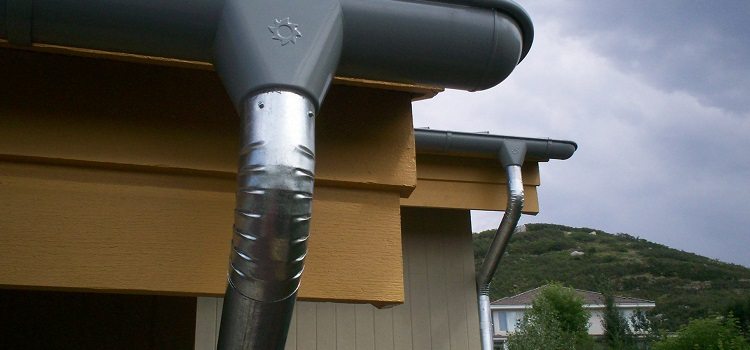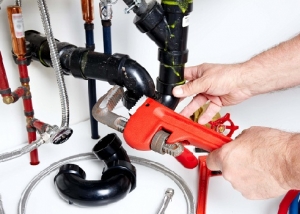Currently, despite the widespread use of plastic pipes, products made of galvanized steel are more often used to create drainage systems. They perfectly perform the function of diverting melt or rain water from the walls, as well as from the foundation of the structure. But only subject to the following essential conditions: the system must have sufficient volume, and the pipes must be absolutely tight.
Content
Drainage classification
As the main criterion for the division of drainage systems into groups, the type of installation is used. Today the drain can be mounted in three ways.
External mounting. It involves the removal of water to the outer pipes through the gutters. Such a system includes:
- wall or hanging horizontal gutters;
- vertical drainpipes;
- plums. With their help, horizontal and vertical components of the drainage system are connected.
When using simple external drainpipes, the appearance of the building is not only affected. In addition, the operation of the drainage system is complicated due to the periodic icing of structural elements in the cold season.
To prevent a complete cessation of water flow, it is recommended to install downpipe anti-icing systems.
Indoor installation. Internal drains include the same structural elements as external. But there is one significant difference. It consists in the placement of pipes for the internal drain. They are mounted behind the components of the curtain wall or in the wall of a building with a flat ceiling. This solution has several advantages. Firstly, with the internal installation of pipes, the exterior of the structure does not change for the worse. And secondly, the pipes do not freeze in winter. However, due to the complexity, the implementation of internal installation can only be entrusted to professionals.
Combined installation. This technology accumulates the advantages of both of the above methods: vertical water conduits are laid inside the wall, while the fastening of the drainpipes themselves is external. Simplified assembly, sophisticated design and excellent frost protection are the main advantages of combined installation. In general, the arrangement of the roof should be carried out taking into account the mandatory slope of the valleys and grooves towards the drainage funnels, evenly located on the lowered sections of the roof.
Advantages and disadvantages of galvanized drainpipes
The production technology of these products looks like this: the finished drainage system, as well as other components of the drain - drains, funnels, gutters, are immersed in bathtubs containing molten zinc. Precipitating a thin layer on the inner and outer surface of the product, the metal creates excellent protection against moisture. After all, zinc is practically not susceptible to corrosion.
Helpful information! Of course, this metal also corrodes. But 10-30 times slower than steel. The anti-corrosion properties of galvanizing are the higher, the less impurities of tin, lead and aluminum are in zinc.
The following advantages are inherent in a galvanized drainpipe:
- resistance to mechanical stress and high strength;
- durability. The service life of a drain from galvanization is about 30-50 years;
- wide range of operating temperatures. Galvanized products do not lose their performance at a temperature of -60≤ T˚≤ + 140˚C;
- fire safety;
- light weight. Do it yourself one person can carry out the installation of drainpipes made of galvanized steel.
The most significant drawback of such a drainage system is poor sound absorption. Metal does not just dampen sound, but, on the contrary, strengthens it. To reduce the noise of the drain, the links of galvanized pipes, elbows, couplings are wrapped, for example, with ordinary mineral wool. But since it is hygroscopic, the sound insulation layer made on its basis should be covered with a film.
External gutters of rectangular cross section. Advantages and disadvantages
For the production of such products, hot dip galvanized steel coated with a polymer, most often pural or plastisol, is used. The main difference between the drainpipes of rectangular section from round products is the installation technology. Sealants and rivets are used to connect them. Compared with the docking of round drainage systems, this process is more complex.
Significant differences also have the fasteners used to fix the rectangular drain to the wall of the house. This is due to the fact that such a design requires a more reliable fastening. For this, fasteners made of galvanized steel with a thickness of up to 4 millimeters, covered with a layer of powder paint, are used.
The geometrical shape of the gutters and pipes in the form of a rectangle in comparison with a round drain, gives the drainage system the following advantages:
- unusual appearance. Indeed, today you can meet such a design quite rarely. Buildings with rectangular gutters are characteristic of the Art Nouveau style of the early XX century;
- high throughput with the same dimensions. From the geometry course of high school it is known that the area of the square is larger than the area of the circle inscribed in it;
- lower cost with equal bandwidth. This follows from the previous paragraph. Indeed, to create a rectangular galvanized gutter system in this case, less material is needed;
- greater level of resistance to mechanical stress. Everyone knows that when freezing, water expands. This phenomenon leads to tensile forces. If we talk about the outer rectangular galvanized drainpipes, then part of these efforts is spent on rounding, bending their walls and only the rest on breaking.
Of course, such a section of the drains causes difficulties in their installation. However, having overcome difficulties once, the homeowner will be able to experience the benefits of a rectangular drainage system over the years of its operation.
Helpful information! Calculations were carried out, where the initial data were taken: for a circular drain - the diameter of the cross section, and for a rectangular one - the length of the wall of the gutter. The results showed that, at their equal values, the cross-sectional area of the rectangular element of the drainage system is 5 (!) Times larger than the round.
When doing this kind of work, you should heed the advice of professionals. For the correct selection of the cross section of pipes and gutters made of galvanized steel, they recommend that you pre-calculate the drainage area. And after the calculations, use the data presented in the table below.
Table 1
| Catchment area, square meters | The cross-section of the pipe when mounting two pipes, millimeters | Pipe cross-section for mounting one pipe, millimeters | Gutter section, millimeters |
| 160-220 | 110 | ________ | 150 |
| 120-200 | 87 | ________ | 150 |
| 80-130 | ________ | 110 | 125 |
| 60-100 | ________ | 87 | 115 |
When installing a drainage system made of galvanized steel, it is necessary to take into account all the subtle aspects of the technologies used. Otherwise, she will not be able to fully carry out the functions assigned to her.










